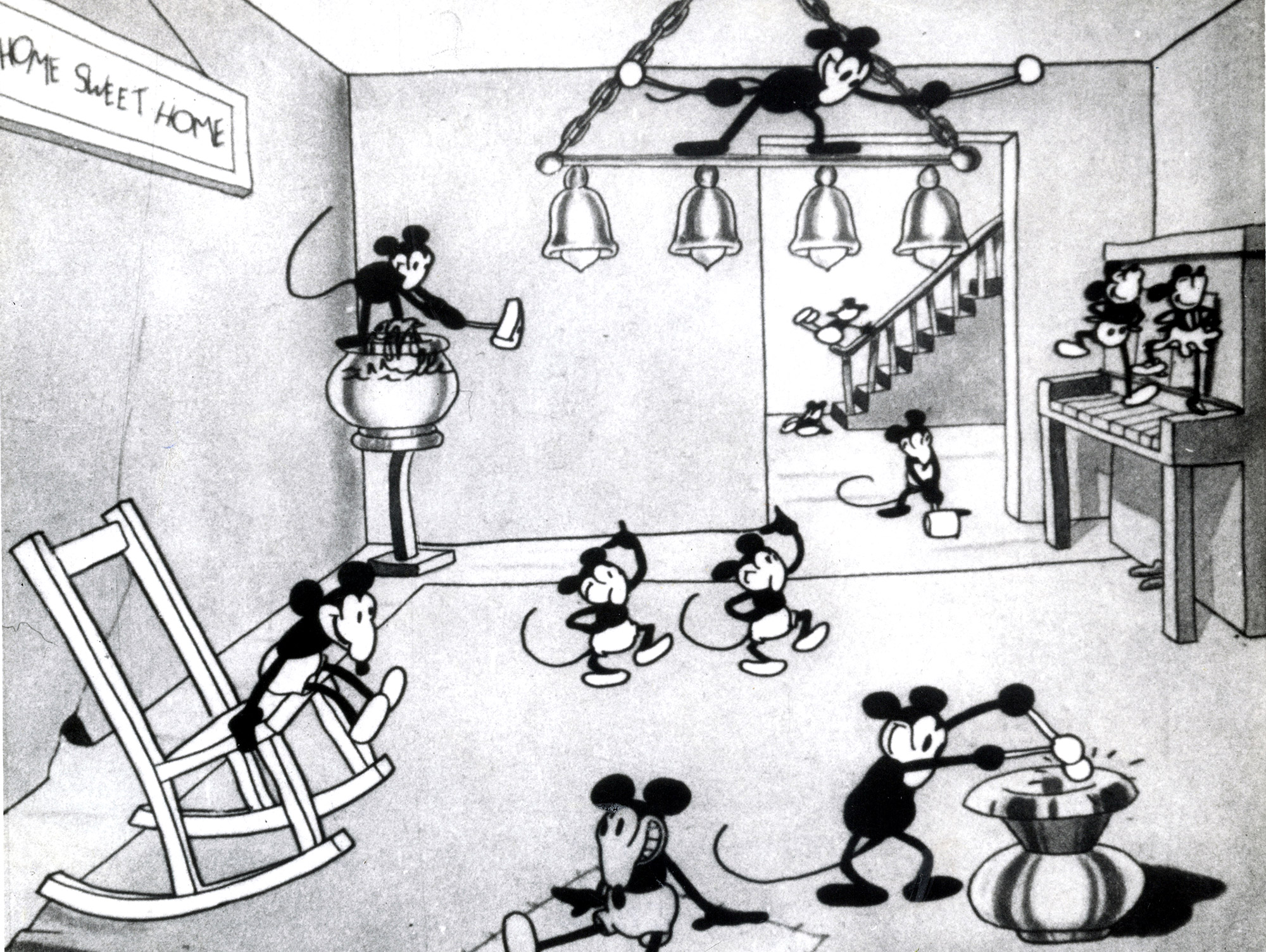
Black and white films
Source: Wikipedia
In Mickey's early films he was often characterized not as a hero, but as an ineffective young suitor to Minnie Mouse. The Barn Dance (March 14, 1929) is the first time in which Mickey is turned down by Minnie in favor of Pete.
The Opry House (March 28, 1929) was the first time in which Mickey wore his white gloves. Mickey wears them in almost all of his subsequent appearances and many other characters followed suit. Supposedly one reason for adding the white gloves was to allow audiences to distinguish the characters' hands when they appeared against their bodies, as both were black. The three lines on the back of Mickey's gloves represent darts in the gloves' fabric extending from between the digits of the hand, typical of glove design of the era.
When the Cat's Away (April 18, 1929), essentially a remake of the Alice Comedy, "Alice Rattled by Rats", was an unusual appearance for Mickey. Although Mickey and Minne still maintained their anthropomorphic characteristics, they were depicted as the size of regular mice and living with a community many other mice as pests in a home. Mickey and Minnie would later appear the size of regular humans in their own setting. In appearances with real humans, Mickey has been shown to be about two to three feet high.[25] The next Mickey short was also unusual. The Barnyard Battle (April 25, 1929) was the only film to depict Mickey as a soldier and also the first to place him in combat. The Karnival Kid (1929) was the first time Mickey spoke. Before this he had only whistled, laughed, and grunted. His first words were "Hot dogs! Hot dogs!" said while trying to sell hot dogs at a carnival. Mickey's Follies (1929) introduced the song "Minnie's Yoo-Hoo" which would become the theme song for Mickey Mouse films for the next several years. The "Minnie's Yoo-Hoo" song sequence was also later reused with different background animation as its own special short shown only at the commencement of 1930s theater-based Mickey Mouse Clubs.[26][27] Mickey's dog Pluto first appeared as Mickey's pet in The Moose Hunt (1931) after previously appearing as Minnie's dog "Rover" in The Picnic (1930).
The Cactus Kid (April 11, 1930) was the last film to be animated by Ub Iwerks at Disney. Shortly before the release of the film, Iwerks left to start his own studio, bankrolled by Disney's then-distributor Pat Powers. Powers and Disney had a falling out over money due Disney from the distribution deal. It was in response to losing the right to distribute Disney's cartoons that Powers made the deal with Iwerks, who had long harbored a desire to head his own studio. The departure is considered a turning point in Mickey's career, as well as that of Walt Disney. Walt lost the man who served as his closest colleague and confidant since 1919. Mickey lost the man responsible for his original design and for the direction and/or animation of several of the shorts released till this point. Advertising for the early Mickey Mouse cartoons credited them as "A Walt Disney Comic, drawn by Ub Iwerks". Later Disney Company reissues of the early cartoons tend to credit Walt Disney alone.
Disney and his remaining staff continued the production of the Mickey series, and he was able to eventually find a number of animators to replace Iwerks. As the Great Depression progressed and Felix the Cat faded from the movie screen, Mickey's popularity would rise, and by 1932 The Mickey Mouse Club would have one million members.[28] At the 5th Academy Awards in 1932, Mickey received his first Academy Award nomination, received for Mickey's Orphans (1931). Walt Disney also received an honorary Academy Award for the creation of Mickey Mouse. Despite being eclipsed by the Silly Symphonies short the Three Little Pigs in 1933, Mickey still maintained great popularity among theater audiences too, until 1935, when polls showed that Popeye was more popular than Mickey.[29][30][31] By 1934, Mickey merchandise had earned $600,000.00 a year.[32] In 1935, Disney began to phase out the Mickey Mouse Clubs, due to administration problems.[33]
About this time, story artists at Disney were finding it increasingly difficult to write material for Mickey. As he had developed into a role model for children, they were limited in the types of gags they could make. This led to Mickey taking more of a secondary role in some of his next films allowing for more emphasis on other characters. In Orphan's Benefit (August 11, 1934) Mickey first appeared with Donald Duck who had been introduced earlier that year in the Silly Symphonies series. The tempestuous duck would provide Disney with seemingly endless story ideas and would remain a recurring character in Mickey's cartoons.
Stay in touch
Hi, I'm Your Name. A short description of your blog. Mickey is a minimal one-column theme for Jekyll. It's designed and developed by @VincentChan.